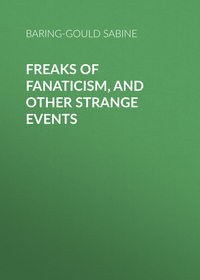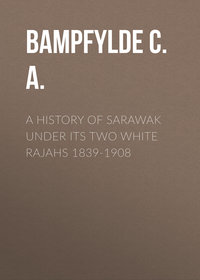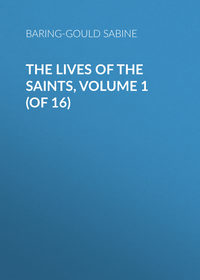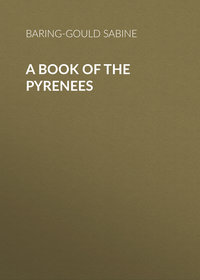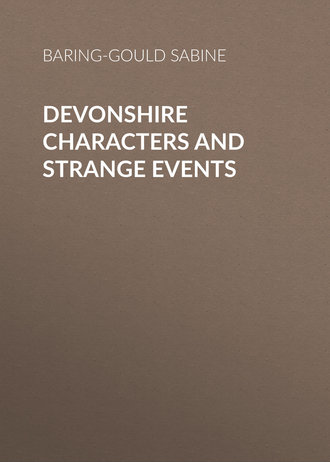 полная версия
полная версияDevonshire Characters and Strange Events
“The painter of the heroic resided a great way off, at the western end of the town. We had some difficulty in obtaining admission to him; a maidservant, who opened the door, eyeing us somewhat suspiciously. It was not until my brother had said that he was a friend of the painter that we were permitted to pass the threshold. At length we were shown into the studio, where we found the painter, with an easel and brush, standing before a huge canvas, on which he had lately commenced painting a heroic picture. The painter might be about thirty-five years old; he had a clever, intelligent countenance, with a sharp grey eye; his hair was dark-brown, and cut à la Raphael, that is, that there was very little before and much behind; he did not wear a neckcloth, but in its stead a black riband, so that his neck, which was rather fine, was somewhat exposed; he had a broad, muscular breast, and I make no doubt that he would have been a fine figure, but unfortunately his legs and thighs were somewhat short.
“My brother gave him a brief account of his commission. At the mention of the hundred pounds I observed the eyes of the painter to glisten. ‘Really,’ said he, ‘it was very kind to think of me. I am not very fond of painting portraits; but a mayor is a mayor, and there is something grand in the idea of the Norman arch. I’ll go; moreover, I am just at this moment confoundedly in need of money, and when you knocked at the door I thought it was some dun. I don’t know how it is, but in the capital they have no taste for the heroic. They will scarce look at a heroic picture.’
“Thereupon it was arranged between the painter and my brother that they should depart [for Norwich] the next day but one; they then began to talk of art. ‘I’ll stick to the heroic,’ said the painter; ‘I now and then dabble in the comic, but what I do gives me no pleasure – the comic is low; there is nothing like the heroic. I am engaged here on a heroic picture,’ said he, pointing to the canvas; ‘the subject is Pharaoh dismissing Moses from Egypt. That finished figure is Moses.’ The picture was not far advanced; as I gazed upon it, it appeared to me that there was something defective – something unsatisfactory in the figure.
“We presently afterwards departed. My brother talked much about the painter. ‘He is a noble fellow,’ said my brother, ‘but, like many other noble fellows, has a great many enemies; he is hated by his brethren of the brush – but above all, the race of portrait painters detest him for his heroic tendencies. It will be a kind of triumph to the last when they hear he has condescended to paint a portrait; however, that Norman arch will enable him to escape from their malice… By the by, do you not think that figure of Moses is somewhat short?’ And then it appeared to me that I had thought the figure of Moses somewhat short, and I told my brother so.
“On the morrow my brother departed with the painter for the old town, and there the painter painted the mayor. The mayor was a mighty, portly man, with a bull’s head, black hair, body like that of a dray-horse, and legs and thighs corresponding – a man six foot high at the least. To his bull’s head, black hair, and body, the painter had done justice; there was one point, however, in which the portrait did not correspond with the original – the legs were disproportionably short, the painter having substituted his own legs for those of the mayor.
“Short legs in a heroic picture will never do; and, upon the whole, I think the painter’s attempt at the heroic in painting the mayor of the old town a decided failure. If I am now asked whether the picture would have been a heroic one provided the painter had not substituted his own legs for those of the mayor, I must say I am afraid not. I have no idea of making heroic pictures out of English mayors, even with the assistance of Norman arches; yet I am sure that capital pictures might be made of English mayors, not issuing out of Norman arches, but rather from the door of the Chequers, or the Brewers Three. The painter in question had great comic power, which he scarcely ever cultivated; he would fain be a Raphael, which he never could be, when he might have been something quite as good – another Hogarth; the only comic piece which he ever presented to the world being little inferior to the best of that illustrious master.”
Borrow was wrong in saying that Haydon did only one comic piece; he did three or four, of which presently.
On 10 October, 1821, Haydon married a widow with two children by the first husband; and to the end he remained devotedly attached to his dear Mary. She had a little money of her own.
He had got £3000 receipts by exhibition of his picture “Christ’s Entry into Jerusalem,” but had to sell it, being short of money, for £240; and he was forced to dispose of his “Raising of Lazarus” to Binus, his upholsterer, to clear off a debt, for £300. He certainly did make a good deal of money, but was always in debt, often without a shilling in his pocket. His huge canvases did not sell. He says of them, in 1826, when Reinagle questioned him about them, “Where is your ‘Solomon,’ Mr. Haydon?” “Hung up in a grocer’s shop.” “Where is your ‘Jerusalem’?” “In a wareroom in Holborn.” “Where is your ‘Lazarus’?” “In an upholsterer’s shop in Mount Street.” “And your ‘Macbeth’?” “In Chancery.” “Your ‘Pharaoh’?” “In an attic, pledged.” “And your ‘Crucifixion’?” “In a hayloft.” “And ‘Silenus’?” “Sold for half-price.” But he was incapable of bending his proud spirit to accommodate his style to the popular taste. He besieged the ministers, he pestered great men to get the Government to encourage High Art. If noble patrons would not buy heroic pictures on huge canvases, the State should do it to adorn public buildings. He took pupils,22 who paid large premiums, and he got them to back his bills, and involved them in heavy outlay to meet them, and then pupils shrank from coming near him. He pestered the nobility, all wealthy men for loans, for grants, for pecuniary aid to help him out of immediate difficulties. He was arrested again and again, and sent to the King’s Bench, had to appear in the Insolvent Debtors’ Court, had distraints levied on his pictures, his furniture, his books. He went about lecturing on Art, and these lectures brought him in a respectable revenue, but he was ever underwater. How he squandered his money does not appear in his journals; but he certainly did earn sufficient with his brush to have maintained himself and his family in respectability had he known how to economize. He got into the hands of moneylenders, and was squeezed. He met with generous aid from numerous quarters, but was no sooner relieved of one pressing call than he fell into fresh difficulties.
If he were taken up by a noble patron and invited to his table, he offended him by contradiction and rudeness. “I do not think I am liked in company, except by women,” he admits in his journal.
The comic painting alluded to by Borrow was thus originated whilst Haydon was in the Debtors’ Prison at King’s Bench: —
“I was sitting in my own apartment, buried in my own reflexions, melancholy, but not despairing, at the darkness of my prospects and the unprotected condition of my wife and children, when a sudden tumultuous and hearty laugh below brought me to the window.
“Before me were three men marching in solemn procession, the one in the centre a tall young, reckless, bushy-headed, light-hearted Irishman, with a rusty cocked-hat under his arm, a bunch of flowers in his bosom, his curtain-rings round his neck for a gold chain, a mopstick for a white wand, tipped with an empty strawberry-pottle, bows of ribbons on his shoulders, and a great hole in his elbow; on his right was another person in burlesque solemnity, with a sash and real white wand; two others, fantastically dressed, came immediately behind, and the whole followed by characters of all descriptions, some with flags, some with staffs, and all in perfect merriment and mock gravity, adapted to some masquerade. I asked what it meant, and was told it was a procession of burgesses, headed by the Lord High Sheriff and Lord Mayor of the King’s Bench Prison, going in state to open the poll, in order to elect two members to protect their rights in the House of Commons. I returned to my room, and laughed and wept by turns! Here were a set of creatures who must have been in want and in sorrow, struggling (with a spiked wall before their eyes) to bury remembrance in the humour of a farce.”
He painted the scene of the “Mock Election in Prison,” and sold it to the King for £525, after having made £321 by it in exhibition. Then he painted another comic picture, “Chairing the Member,” for which he got £422, beside £168 by exhibition. A third humorous picture was “Punch and Judy.”
But though he made money by these paintings in the style of Hogarth, he hated doing them. His soul soared to High Art.
“At the table of Mr. Wyatt,” says the Rev. J. Richardson in his Recollections (London, 1856), I met the late Mr. Haydon, the artist, with whom I had been previously acquainted. Haydon was undoubtedly a man of considerable talent, but of insatiable vanity. He had concentrated in his own estimation of his merits those atoms of admiration that ought to have been diffused among the general community, who were certainly somewhat slow in recognizing the claims which he was continually urging; indeed, they were far too slow to satisfy his craving for applause, and for a slice or two of that solid pudding which many people value much more than empty praise. The consequence was that he was continually indulging in querulous complaint and bitter vituperation; everybody was rewarded except himself; nobody but himself had any merit or capacity or feeling for Art. All the world were fools; he was the little bit of leaven that was to bring the solid lump into fermentation; the one wise man whose presence rescued the mass of mankind from unqualified insignificance and fatuity. This inordinate vanity overlaid the many good qualities which he possessed, blinded his perspicuity, and perverted his judgment.”
On 16 October, 1834, the Houses of Parliament were consumed by fire, and Barry was entrusted with designs for the erection of a new palace, which was begun in 1840. Now was the opportunity for which Haydon had yearned. The new Houses of Parliament must receive decoration in fresco. In 1842 a Fine Arts Commission issued a notice of conditions for a cartoon competition. Haydon welcomed this with delight. Who but he was competent to execute such great works? And he laboured hard at the study of fresco and in the preparation of cartoons. But he was disappointed at not being given the chief place, without question, in the decoration of the Houses.
“After thirty-eight years of bitter suffering,” he wrote, “perpetual struggle, incessant industry, undaunted perseverance, four imprisonments, three ruins, and five petitions to the House – never letting the subject of State support rest night or day, in prison or out; turning everything before the public – the wants of his family, the agonies of his wife, the oppression of the Academy, directing all to the great cause [of High Art], it is curious to see that the man who has got hold of the public heart, who is listened to and hailed by the masses – it is curious, as a bit of human justice, to find chairman, committee, witnesses, pupils, avoid throughout the whole inquiry any thought, word, or deed which could convey to a foreign nation or a native artist, a noble lord or an honourable member, that there was such a creature as Haydon on the earth!”
The opening of the Cartoon Exhibition was fixed for 3 July, 1843. Already, on 27 June, Haydon had received intelligence that his cartoons had been rejected. It was a bitter blow. But he struggled on till April, 1846, when he received another, that was final, and crushed his spirits. His cartoons should be seen and appreciated by the public. He hired a room in the Egyptian Hall, Piccadilly, in which to exhibit them, together with some of his historical paintings – “Aristides Banished from Naples,” “Nero Playing upon his Harp whilst Rome was Burning,” and some others. In the large front room of the Egyptian Hall, General Tom Thumb was holding his levees, and a swarm of people crowded to these, and very few looked in on Haydon’s exhibition.
In his diary he enters: “21 April. Tom Thumb had 12,000 people last week. B. R. Haydon 1331⁄2 (the 1⁄2 a little girl). Exquisite taste of the English people!”
He closed his exhibition on 18 May, and had lost by it £111 8s. 10d. He wrote: “I have not decayed, but the people have been corrupted. I am the same, they are not.”
This was a wound so severe to his vanity that it never healed. He abused the public, contrasting his own merits with those of his diminutive rival, and mixing up the sublime with the ridiculous in such a manner as to make his complaints the source of laughter rather than of commiseration. He was at some moments in so excited a condition from his own disappointment, contrasted with the success of the dwarf and the showman, that he appeared to his friends to be almost insane.
On 22 June he wrote in his diary the lines from Lear: —
Stretch me no longer on this rough world.This was written between half-past ten and a quarter to eleven o’clock on that morning. He was in his studio. About a quarter to eleven his wife and daughter heard the report of firearms, but took little notice of it, as they supposed it to proceed from the troops then exercising in the Park. Mrs. Haydon went out. Miss Haydon entered the painting-room, and found her father stretched dead before the easel on which stood his unfinished picture of “King Alfred and the First English Jury” – his white hairs dabbled in blood, a half-open razor smeared with blood at his side, near it a small pistol recently discharged, in his throat a fearful gash, and a bullet-wound in his skull. A portrait of his wife stood on a smaller easel facing his large picture. On a table near was his diary open at the page of that last entry, his watch, and a Prayer Book open at the Gospel for the Sixth Sunday after the Epiphany, and his will.
The coroner’s jury found that the suicide was committed when Haydon was in an unsound state of mind. In fact, he had been driven mad by mortified vanity. His debts at his death amounted to about £3000. The assets were inconsiderable. Liberal and immediate assistance and much sympathy were extended to the bereaved widow and family.
Posterity has not seen occasion to reverse the judgment of his contemporaries on Haydon’s paintings.
His engrossing love of art, with his consciousness of great powers, and excessive self-esteem, made him a most enthusiastic devotee to any work which he had on his easel, and enabled him to bear up long against the thousand interruptions from embarrassed circumstances which are detailed in his Autobiography. Whilst painting his “Maid of Saragossa” he accidentally wounded his foot with a bayonet, but went on with the picture, using his own blood as a pigment, till the surgeon arrived.
Zeal, devotion, high thoughts, ability in composition, some power in colouring, and correct anatomical drawing may and ought to be conceded to Haydon. But he aimed at subjects beyond his power of execution, and in all his High Art paintings there is a lack of refined feeling and good taste. Thus, in the “Judgment of Solomon” the king is depicted as treating the whole affair as a practical joke. Mr. Watts, the artist, says: “The characteristics of Haydon’s art appear to me to be great determination and power, knowledge and effrontery. His pictures are himself, and fail as he failed. In Haydon’s work there is not sufficient forgetfulness of self to disarm criticism of personality. His pictures are themselves autobiographical notes of the most interesting kind; but their want of beauty repels, and their want of modesty exasperates. Perhaps their principal characteristic is want of delicacy of perception and refinement of execution. His touch is generally woolly, and his surface disagreeable.”
He was determined to force his idea of the Heroic in Art on a public that had got beyond gods and goddesses and the heroes of the Greeks and Romans. He would have done well at the Court of Louis XIV, but he was out of date at the dawn of the naturalism of the nineteenth century.
The public, thought Haydon, were sick, and knew not what Art was. They must be forced, scolded, lectured, rated to admire it. The last thing that would occur to him would be to study the trend of public taste and to adapt himself to it.
When drawing his cartoons for the Houses of Parliament, he would not even consider what was fitting. Had he sent in his “Alfred and Trial by Jury,” it might and probably would have been approved; but instead he sent pictures from the Reign of Terror in France to represent Anarchy, which was of all things unsuited for the new palace, that did not desire scenes from French history, and those recent ones.
And his huge cartoons were a mistake. Epics are not for the masses, and only great public buildings could contain these canvases. Public bodies did not care to spend large sums upon pictures for town halls and exchanges.
“What a game you have thrown away!” said a friend to Haydon one day; and we must echo that opinion in considering the life before us. It was a game utterly and irretrievably, through vanity and pig-headedness, thrown away.
JOHN COOKE
By a public character in his wayYou may find an anecdote of the day,I wish every line to tell, and word I say.Thus “Captain” John Cooke, the Exeter saddler, begins his pamphlet, Old England for Ever, published by Curson, of Exeter, in 1819.
John Cooke was born at the “Rose and Crown” public-house, on the old bridge, at Ashburton, in 1765. Ashburton, says Cooke, was not only famous as producing Dunning, Lord Ashburton, but also for its Pop. “I recollect its sharp feeding good taste, far richer than the best small beer, more of the champagne taste, and what was termed a good sharp bottle. When you untied and hand-drew the cork it gave a report louder than a pop-gun, to which I attribute its name; its contents would fly up to the ceiling if you did not mind to keep the mouth of the stone bottle into the white quart cup; it filled it with froth, but not over a pint of clear liquor. Three old cronies would sit an afternoon six hours, smoke and drink a dozen bottles, their reckoning but eightpence each, and a penny for tobacco. The pop was but twopence a bottle. It is a great loss to the town, because its recipe died with its brewer about 1785.”
Another drink of the past was white ale. This derived its name from its appearance, not unlike tea freely diluted with milk and having considerable quantities of some white curdy substance floating about in it, which had a tendency to settle at the bottom of the glass. The secret of its composition lay in the nature of the ferment employed, called “grout.” At one time white ale was a common drink in South Devon; now it is as dead as Ashburton Pop and John Dunning.
John Cooke’s father was a plasterer and “hellier” – i.e. slater – but turned publican and maltster, and kept the tavern in which his son was born. John’s grandfather brought the water into the town to the East Street conduit. At the age of fifteen his mother, then a widow, put John apprentice to Chaster, a saddler in Exeter, and on the death of Chaster, Cooke succeeded to the business at the age of twenty-one, and was highly esteemed in the county for the excellence of his work and his knowledge of how to fit the back of a horse. He made saddles for Lord Rolle, Sir Stafford Northcote, Sir John Duntze, Sir Robert and Sir Lawrence Palk, Sir Thomas Acland, and last, but not least, for Lord Heathfield. “His lordship was allowed to be one of the best judges of horses and definer of saddlery in the kingdom; his lordship’s saddle-house consisted from the full bristed to the demi-pick, Shafto, Hanoverian, to the Dutch pad-saddles; and from the snaffle, Pelham, Weymouth, Pembroke, Elliott, Mameluke, and Chifney bridles. His lordship’s saddle and riding-house was a school for a saddler and dragoon.”
Cooke breaks into rhyme: —
As few began the world so I multiplied,I’ve gratitude to all my friends, who’ve supplied.Plain at twenty-one, I did begin,Which in my manuscript was seen,Tho’ years at school with arithmeterians,Who wrote well, but they are no grammarians,Tho’ I did not know the use of grammarI was well supported by my hammer.I sticked to my King, leather and tools;And for order wrote a set of shop rules.It’s not what work is brought for to be only done,Every think that’s necessary, buckle or tongue;For instance, a saddle is brought to stuff, that’s all,A stirrup-bar is wanted to prevent a fall;All your work must be done well, not like fools,For if it breaks on the road, there’s no tools.Working with the hands only is but part,The head’s the essential to make work smart.Be John Bulls, true to your country and Church,Always tell the truth and don’t never lurch.John Cooke’s saddlery was better than his grammar and his orthography, and his faults in these latter particulars called down upon him the scorn of Andrew Brice, the printer and publisher of a weekly paper. Cooke was a strong loyalist, and Brice was touched with republican ideas.
“Brice,” says Cooke, “posted me about the streets with halfpenny papers; and the poor hawkers got many pence through me; but all that he could do or say was to degrade my orthography; but to lessen my loyalty or character he could not; from his art or out of burlesque he said my letters were after the manner of Junius, and at the same time said I was of Grub-street. I winked at all this, whilst the people read my bulletins. I confess I did not know Junius’s Letters or Grub-street then, but I know them now. At the attack and at different times he wanted to run aground my loyal advertisements; but, poor man, he ran himself aground dead.”
The bulletins and advertisements animadverted upon by Brice were handbills issued by Cooke opposing the republican inflammatory pamphlets that were put in circulation, as also bulletins of the news with comments of his own which he pasted up outside his shop. There was at the time a noisy party in England in favour of Bonaparte, and this was the Radical and Republican party. Cooke was taunted by these as a bull-calf. He replied that he gloried in the name of John Bull. “Even when the friends of one of the candidates at the recent general election at Exeter came to solicit my vote (I thank God I vote for six members) I told them that I would not vote for a man of such principles if they would give me £500. When I came to give my vote at the Guildhall, Mr. Sergeant Pell rose up out of fancy or fun, and said to me, Are you not a Frenchman? I said, A Frenchman! No, sir, I am a true John Bull. He said, Of the calf kind. I said, It must be a calf before it’s a bull. The Sergeant sat down.”
In 1789 Cooke was made captain to the sheriff’s troop. “About this time there were commotions by the mobility in London against his Majesty’s minister, Mr. Pitt. I went into the pot-houses at Exeter, and treated with mugs round, and gave loyal toasts and sentiments – my own motto, Any income-tax sooner than a French-come-tax; a long pull and a strong pull and a pull altogether-mind how the fox served the chicken, and said the grapes were sour – a speedy necklace to all traitors – Old England for ever, and those who don’t like it, leave it.
“There has been but one small riot in Devonshire, to its honour and credit, and that was stopped in its infancy. It was for breaking into a miller’s house to get corn by violence; one Campion, a blacksmith, a young man called out from his work inadvertently to join the mob; from farmhouse to house they got liquor, got inebriated. He became a leader and carried a French banner, the old story. Campion was desired to desist by gentlemen; but he would not. He was apprehended in a day or two, committed to gaol, and tried at the Assizes, 1795, before the late Justice Heath; the jury found him guilty of the felony – riot and sedition. He suffered death. This prompt measure put an end and stopped the contagion in the West. There were thousands of spectators on the road, besides a thousand military of dragoons, artillery and volunteers of the district, who escorted him thirteen miles to the place of execution, Bovey-heathfield, in sight of his own village, Ilsington, as a rescue was talked of.
“At a foolish County Meeting in 1797, to petition his Majesty to remove his late Minister, Mr. Pitt, I called up my apprentices at 3 o’clock in the morning; we got a ladder, and scaladed the walls of the Castle of Exeter, got in unperceived, I wrote conspicuously No petition, no civil war, and at many more lofty hazardous places in the city, that the freeholders might read it when they came to the meeting; we (had) done the whole before the people were up. I again put out handbills warning the mobility of Exeter of riot; and at the show of hands by the Sheriff the mob held up both their hands, and there was a great majority of legal (loyal) votes.





